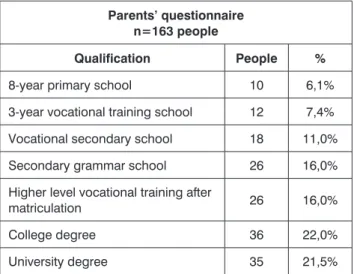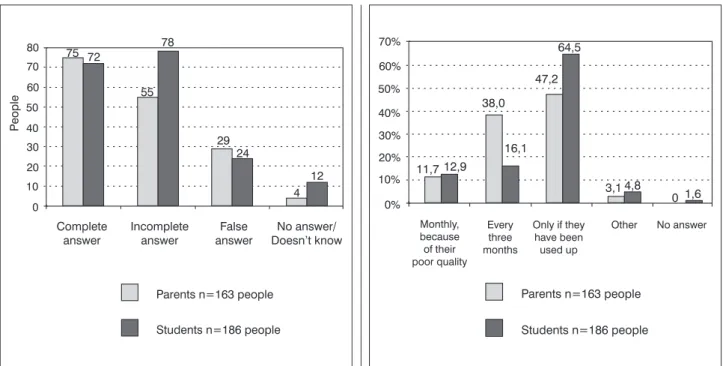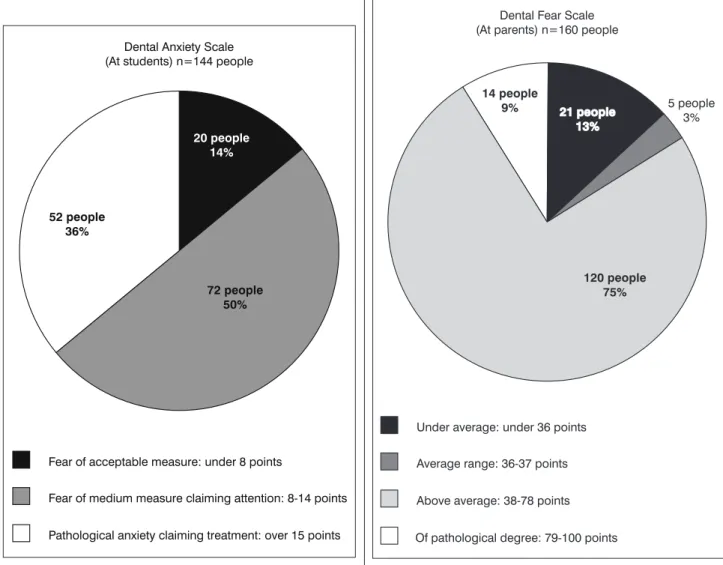© Borgis o r i g i n a l p a p e r s
Dental HealtH BeHaviour
of aDolescents anD tHeir Parents
Júlia Bartos
1, *Judit Mészáros
21Dentist, student of Semmelweis University PhD School Scientific counsellor: Dr. Sándor Hollós, PhD
2Psychologist, Dean of the Faculty of Health Sciences, Semmelweis University Rector of Semmelweis University: Prof. Dr. Ágoston Szél
summary
the aim of the first chapter of the two-part study is to explore and to show dental-care patterns, oral hygiene knowledge and dental fear of a given age group of Hungarian young people (12-16 years) and their parents. in the 344-person sample we ap- plied a questionnaire made by ourselves and two standard tests (Dfs and Das) as our data-collection and research method.
in the results we compared common and different aspects of the children’s and adults’ behaviour and concluded that there are some differences in the children’s and adults’ dental attitude. in the conclusions we recommend the necessary and indispens- able development of the oral-hygiene culture considered a slightly neglected area and the alleviation of the phenomenon of dental fear by means of professional prevention.
Key words: oral hygiene patterns, dental-care culture, health behaviour, parent example, dental fear
IntRoDUctIon
People of present days do not appreciate too highly their healthy sets of teeth, though teeth have several im- portant functions in our everyday lives: chewing, sound formation, digestion, speaking – and by no means neg- ligible aesthetic function indispensable for feeling well, for positive self-esteem. that’s why it is essential to in- clude and apply dental prevention in medical practice moreover educating, training and instructing specialists assisting in dental care is also of great importance in this preventive aspect and practice.
this paper touches a specific branch of health sci- ences, the borderland between dentistry and health promotion and describes knowledge of dental-hygiene, dental fear and the possibilities and health-promotion and psychoeducation dealing with this special field.”to examine children-population was highly reasonable since a research independent of ours (Alberth and colleagues, 2002) had already published data on the 12-14 age-group and showed that the value of the Hungarian children’s dental fear is high just like at the adult population” (1).
Unfortunately, generaly neglected oral hygiene, or its total lack means a too frequent problem in dental health education. Its development is mainly attributable to the ig- norance of parents and their children, their wrong health promotion knowledge, the parents’ lack of time and indif- ferent attitude.”It is very difficult to set a good example, since parents themselves are ignorant and do not sup- port their children’s education for oral hygiene because of lack of time. their own health-culture is also on a basic level so they cannot give a good example either.” (2).
For the studied target group family patterns, oral hy- giene socialisation patterns may be decisive and if the skill-level interiorization of dental hygiene culture as an everyday value and practice has not been important in the family traditions the teenager can only include it into his/her everyday life by his/her own cognition and in- ner motivation. thus he/she can be followed as a good, positive model just for the reason that outer appear- ance, visuality, good-looking and the desire to be liked are very important in this very sensitive period of life.
Moreover at this age a painful dental intervention may also become a behaviour generating fear since adoles- cents can react sensitively, unexpectedly, with psychic instability on events around and connected with them.
the phenomenon of dental fear is a component of the attitude towards dental issues. the development of fear is usually bound to an unambiguous cause – in the present case the idea, awareness of dental intervention, the sight of the dentist, smells typical for dental surger- ies, or simply mentioning the topic may also elicit fear.
’the increased dental fear is a relatively frequent phe- nomenon, international data show that the involvement of West-European and north-American avarage popula- tion is between 5-15%, in certain researches there occur values even higher than this, though (3).
In a narrow and limited sense of the word dental fear can develop in an individual in connection with dental interventions and in pathological cases in such a degree that this negative emotion will induce changes in behav- iour or conduct. thus e.g. consant time delay, strenghen- ing of defence mechanisms, abnormal inwardness, hys-
table 1 . Gender distribution.
gender distribution students n=186 people
Girl 108 58%
Boy 78 42%
Average age 14 years
table 2. Gender distribution II.
gender distribution ii Parents n=163 people
Female 132 81%
Male 31 19%
Average age 43 years
teria, psychosomatisation might also be concomitants and at the same time consequences of severe dental fright. the studied age group is increasedly exposed to the appearance of dental fear, since the frequent phe- nomenon of emotional waves, learning emotional con- trol, struggle for forming an ideal self-image and realis- tic self-knowledge are the most important corollaries of adolescence.
AIM
the two-sample survey is surrendered to three main research aims: partly to explore the dental- and oral hy- giene knowledge and patterns of 12-14 year-old second- ary school students and their parents, partly to compare the main features of children’s and parents’ attitudes to- wards tooth care and dental issues and also to describe the process how parents and children learn their health behaviour and thirdly to outline the possibilities of pre- vention and health promotion in the development of oral hygiene culture.
MAtERIAl AnD MEtHoDS
the sample of the research is of two age groups: 168 adolescents and 163 parents have completed the ques- tionnaires validly. the adolescents are students in Bu- dapest secondary schools, the survey was carried out in the schools, in different programs and in dental surger- ies when the questionnaires were immediately returned.
the gender distribution of the sample (tab. 1) shows that more girls than boys completed the questionnaires and the average age of the respondents was 14 years.
Among the respondent parents the proportion of fe- males was also higher and the adults’ average age was 43 years (tab. 2).
As for the qualification of parents: most of them enjoy a higher education degree (71%) and only 13.5% don’t have a secondary shool leaving certificate at least (tab. 3).
In our research we used two types of question- naires: a questionnaire of 20 coled questions made by ourselves and two standard tests. When evaluat- ing the open questions in our own questionnaire we grouped the answers in four categories: ”complete”,
”incomplete”, ”false” and ”no answer”. Furthermore for the adolescents we used the Dental Anxiety Scale (DAS), which was first published in 1969 as the first test measuring dental fear (4). the scale contains four questions, each of them can be evaluated from 1 to 5 points depending on the degree of fear. So the mini- mum value to be obtained is four, the maximum twenty points. there are several scales for the evaluation, we accepted the ranges considered standard by Hake- berg and colleagues (3).
For parents we applied another test, the Dental Fear Scale (DFS), which was first published in 1973, contains 20 questions and the respondent can select the level of fear on a five-point scale. the evaluation categories for this test were set by Johansson (5).
RESUltS
Among the questions relating to the general dental and oral hygiene knowledge approximately the same proportion of parents and children (72 and 77 people) gave ”complete” i.e. correct answer to the question about the reasons for using a mouth-shower (fig. 1).
”Incomplete” answers were characteristic rather for the students (78 people), while ”false” answers were mainly given by the parents (29 people).
Knowledge about tartar/plaque formation proved to be ”incomplete” in both samples, 59 of the parents and 98 of the students only guessed what tartar was and why it should be removed. Adolescents were better informed:
32 parents’ and 45 students’ answers were ”complete”
about this question and the proportion of ”false” an- table 3 . Parents’ questionnaire
Parents’ questionnaire n=163 people
Qualification People %
8-year primary school 10 6,1%
3-year vocational training school 12 7,4%
Vocational secondary school 18 11,0%
Secondary grammar school 26 16,0%
Higher level vocational training after
matriculation 26 16,0%
college degree 36 22,0%
University degree 35 21,5%
swers was also higher among the parents (46 people).
Furtheron 26 parents and 20 students could not give any explanation about the nature of tartar (fig. 3).
the cause of gum bleeding/gingival was explained correctly by 65 poeple among the students and 36 of the parents. the explanation for gum bleeding given by 70 students was ”incomplete” while most adults gave
”false” answers (57 people). the answer ”I don’t know /no answer” was selected by four times more parents than adolescents (28 and 6 people) (fig. 4).
Most answers about using dental floss – given both by parents and by students – fall into the category: ”I never use any” (109 and 108 people). 60 of the students uses dental floss occassionally and only 27 parents selected this possibility. 26 parents and 18 students regularly use dental floss (fig. 5).
Most respondents, 41.1% of parents and 50% of stu- dents – choose the type of toothbrush depending ont he characteristics of the teeth and gum, for 19.6% of the adults and 21% of the students it does not matter what Fig. 1. Why to use mouth-shower? Fig. 2. How often to change toothbrushes?
Fig. 3. What is tartar/plaque and why to remove it? Fig. 4. What does gum bleeding/gingival indicate?
type of toothbrushes they use. 9.25% of the parents and 1.6% of the students voted for the type just advertised in the media (fig. 6).
Dental check-up in every half a year is considered necessary by 67.7% of the students, while 41.7% of the parents think yearly dental check-up necessary. 33.1%
of the adults think that to see the dentist is necessary only when someone has complaints, 9.7% of the stu-
dents shares this opinion. no significant difference can be shown between the parents’ and children’s data sets (t = 0.15; p < 0.005) (fig. 7).
As regards the emotional attitude towards dental treatments 35% of the adults and 11.3% of the students go to dental surgeries with fear, 43.5% of the student is indifferent when going to the dentist’s, as against the 17.8% of the parents. the answer ”the same as at other Fig. 5. Patterns for using dental floss. Fig. 6. type of the optimal toothbrush.
Fig. 7. Frequency of dental check-up. Fig. 8. How you feel when going to the dentist?
physicians” was selected by 42.9% of the adults and 43 % of the students. there is no significant difference between the data sets (t = 0.22; p< 0.005) (fig. 8).
the results of the standrad dental fear test show that only 20 students’ dental fear is of acceptable measure. Most respondents are scared of dental treatments in a medium degree, which need attention and 52 people have serious dental anxiety as a dental patient (fig. 9).
In their dental anxiety scale most parents (75%) re- late to dental treatments with higher than average fear, while only 5 parents belong to the range of fear of aver- age measure. 13% of the adult respondents do not feel real fear of the dentist, while 14 people sit into the dental chair with anxiety of pathological degree.
As regards the dental care among the priorities of ex- pectations towards dental surgeries the first place goes to the professional competence of the staff, the good reputation of the team working in the surgery. the com- munication style of the experts has the second pülace, while the third factor in the rank is punctuality, keeping the appointment. the respondent parents put the as- pect of accessibility and the importance of the objects, milieu to the last place.
Fig. 9. Dental Anxiety Scale. Fig. 10. Dental Fear Scale.
DIScUSSIon
1. When defining dental phenomena/tartar, gum bleed- ing/parents seemed to show more ignorance and lack of knowledge than students, which might be ex- plained by that young people are more receptive to new information, their knowledge is fresher and more up-to-date. Due to their age they are more attentive to educational publications, public service advertise- ments, messages of educational campaigns.this fact is also proved by our results: among ’false answers’
the proportion of adult respondents was higher and more children gave ”incomplete” answers.
2. the use of dental floss, which is considered modern in dental care is typical for parents in the same rate as it is for their children, i.e. family example effects on the young people’s patterns.
3. When choosing the optimal toohtbrush – quite sur- prisingly – parents are more influenced by the media than their children, i.e. our results show that adults are more susceptible customers as regards dental- care tools.
4. there cannot be significant difference shown in the question of dental attitude, but both the results of
table 4 . Rank what is important for you in a dental surgery.
Place of rank 1. 2. 3. 4. 5. 6.
competence, good reputation of the staff people 67 30 11 16 23 8
Easy access 33 5 5 14 25 69
Material /financial, human correctness 24 41 14 27 41 8
Kindness, communication of the staff 14 52 31 36 13 6
Milieu, objects, facilities 13 16 34 22 24 45
Keeping the time, punctuality 5 9 60 40 27 15
other/no answer 7 10 8 8 10 12
standard questionnaires and those of our own ones prove that parents show stronger fear towards den- tal treatments. Very likely they have more negative, frightening previous ex perience than their adoles- cent children.
5. children consider regular dental check-up is neces- sary more frequently than their parents, which is a promising and instructive result from preventive point of view.
6. In the rank of aspects set by the adults for choosing a dental surgery professionalism, competence, help- ing-advising communication have priority, i.e. human factors are of greater importance thatn other practical aspects (vicinity, milieu, facilities, etc).
conclUSIonS
1. It is worthwhile to expand the primary and second- ary dental prevention both to adolescents and their parents since in both age-groups the lack of up-to- date information and general knowledge can be de- tected.
2. In the adolescent group the chance to prevent the development of dental fear is great since they hardly have any negative experience.
3. organising behaviour-shaping campaigns and ad- equate health education programs would be neces- sary to prevent or decrease the strong dental fear of parents.
4. Dental health behaviour should be shaped only holistically, since misbeliefs, wrong oral hygiene knowledge, ignorance and entrenched patterns of- ten go together with the phenomenon of strong den- tal fear.
5. the importance of the message of the expertly and consciously applied helping-healing communication, verbal and non-verbal signs is undisputed in the pre- vention of the development of dental fear. ”Another key factor of prevention is the quality of the dentist’s activity. Without high-quality dentist-patient commu- nication, the maximum pain relief… elimination of in- necessarily frightening aspects we can’t speak about real, efficient prevention” (6).
References
1. Alberth M, Gál N, Nemes J, Töviskes M: Máth J. 12-14 éves gy- erekek fogászati félelmének és szorongásának hatása a fogazati állapot alakulására. Fogorvosi Szemle 2002; 95: 113-117. 2. Pintér A: Néhány szó a fogszuvasodás megelőzéséről. Egészségnevelés. 34: 68-69.
3. Hakeberg M, Berggsen U, Carlsson S: Preveloance of dental axiety ina n adult population in a major urban area in Sweden. Community Dent Oral Epidemiol 1992; 20: 97-101. 4. Fábián TK és munkatársai: A Dental Fear Survey (a„Fogászati félelem kérdőív) magyar fordítása, hazai popu- láción végzett mérések eredményei. Fogászati Szemle 1999; 92:307-315.
5. Jonasson P, Berggsen U: Assessement of dental fear. A comparison of two psychometric instruments. Acta Odontol Scand 1992; 50: 43-49.
6. Fábián G: A fogászati félelem okai, prevenciója és terápiás lehetőségei, különös tekintettel az orthodontiai és gyermekfogászati gyakorlatra, PhD értekezés 2008, p.125. Semmelweis Egyetem, Budapest.
correspondence to:
*Judit Mészáros Semmelweis University Faculty of Health Sciences
17 Vas St. 1088 – Budapest, Hungary tel.: +36 1 486 5910 e-mail: meszarosj@se-etk.hu Received: 07.05.2012
Accepted: 25.05.2012




